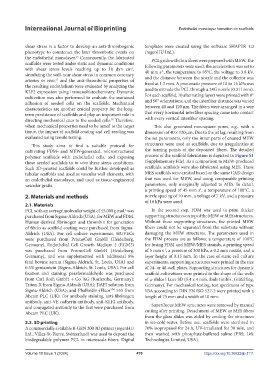Page 487 - IJB-10-1
P. 487
International Journal of Bioprinting Endothelial monolayer formation on scaffolds
shear stress is a factor to develop an anti-thrombogenic templates were created using the software SHAPER 1.0
phenotype to counteract the later thrombotic events on (regenHU Ltd.).
the endothelial monolayer. Consequently, the fabricated PCL grids with thin fibers were prepared with MEW. The
15
scaffolds were tested under static and dynamic conditions following parameters were used: the acceleration was set to
with shear stress levels reaching up to 10 dyn cm , 40 mm s , the temperature to 85°C, the voltage to 3.8 kV,
2
-1
simulating the wall-near shear stress in common coronary
arteries in vivo, and the anti-thrombotic properties of and the distance between the nozzle and the collector was
17
the resulting endothelium were evaluated by analyzing the fixed at 1.3 mm. A pneumatic pressure of 10 to 15 kPa was
KLF2 expression using immunohistochemistry. Dynamic used to extrude the PCL through a 24G nozzle (0.311 mm).
cultivation was also performed to evaluate the sustained For each scaffold, 10 alternating layers were printed with 0°
adhesion of seeded cells on the scaffolds. Mechanical and 90° orientations, and the interfiber distance was varied
characteristics are another crucial property for the long- between 40 and 120 µm. The fibers were arranged in a way
term persistence of scaffolds and play an important role in that every horizontal interfiber spacing came into contact
directing mechanical cues to the seeded cells. Therefore, with every vertical interfiber spacing.
18
when mechanical properties need to be tuned to the target This also generated non-square pores, e.g., with a
tissue, the impact of scaffold coating and cell seeding was dimension of 40 × 120 µm. Due to the jet lag, resulting from
evaluated using tensile testing. the set parameters, only the inner parts of created MEW
This study aims to find a suitable protocol for structures were used as scaffolds, due to irregularities at
cultivating FDM- and MEW-generated, microstructured the turning points of the deposited fibers. The detailed
polymer scaffolds with endothelial cells, and exposing process of the scaffold fabrication is depicted in Figure S1
those seeded scaffolds to in vivo shear stress conditions. (Supplementary File). As a comparison to MEW-produced
Such 3D-printed scaffolds could be further developed as scaffolds, scaffolds were also fabricated using MES. These
tubular scaffolds and used as vascular wall elements, with MES scaffolds were created based on the same CAD design
an endothelial monolayer, and used as tissue-engineered that was used for MEW, and using comparable printing
vascular grafts. parameters, only marginally adjusted to MES. In detail,
a printing speed of 45 mm s , a temperature of 100°C, a
1
2. Materials and methods nozzle spacing of 10 mm, a voltage of 7 kV, and a pressure
of 10 kPa were used.
2.1. Materials
PCL with an average molecular weight of 45,000 g mol was In the second step, FDM was used to print thicker
-1
purchased from Sigma-Aldrich (USA), for MEW and FDM. supporting structures on top of the MEW or MES structures.
Human-derived fibrinogen and thrombin for generation Without these supporting structures, the printed MEW
of fibrin as scaffold coating were purchased from Sigma- fibers could not be separated from the substrate without
Aldrich (USA). For cell culture experiments, HUVECs damaging the MEW structures. The parameters used in
were purchased from PromoCell GmbH (Heidelberg, the FDM process are as follows: a temperature of 100°C
Germany), Endothelial Cell Growth Medium 2 (EGM2) for fusing FDM and MEW/MES strands, a printing speed
was purchased from PromoCell GmbH (Heidelberg, of 5 mm s , a pressure of 300 kPa, a 0.2 mm nozzle, and a
-1
Germany), and was supplemented with additional 8% layer height of 0.15 mm. In the case of static cell culture
fetal bovine serum (Sigma-Aldrich, St. Louis, USA) and experiments, supporting structures were printed in the size
0.5% gentamicin (Sigma-Aldrich, St. Louis, USA). For cell of 24- or 48-well plates. Supporting structures for dynamic
fixation and staining, paraformaldehyde was purchased scaffold cultivations were printed in the shape of the wells
from Carl Roth GmbH + Co. KG (Karlsruhe, Germany); of µ-slides I Luer 3D (5.4 x 4 mm, ibidi GmbH, Gräfelfing,
Triton-X from Sigma-Aldrich (USA); DAPI solution from Germany). For mechanical testing, test specimens of type
Sigma-Aldrich (USA); and Phalloidin-iFluor 555 from 1BA according to DIN EN ISO 527-2 were printed with a
TM
Abcam PLC (UK). For antibody staining, anti-fibrinogen length of 75 mm and a width of 10 mm.
antibody, anti-VE cadherin antibody, anti-KLF2 antibody, Superfluous MEW structures were removed by manual
and conjugated antibody to the first were purchased from
Abcam PLC (UK). cutting after printing. Detachment of MEW or MES fibers
from the glass slides was aided by cooling the structures
2.2. 3D printing in ice-cold water. Before use, scaffolds were sterilized in
A commercially available R-GEN 200 3D printer (regenHU 70% isopropanol for 24 h, UV-irradiated for 30 min, and
Ltd., Villaz-St-Pierre, Switzerland) was used to deposit the then washed with phosphate-buffered saline (PBS; Life
biodegradable polymer PCL in microscale fibers. Digital Technologies Limited, USA).
Volume 10 Issue 1 (2024) 479 https://doi.org/10.36922/ijb.1111

